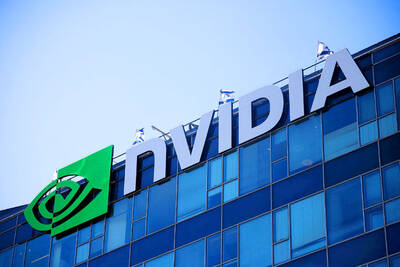Shell PLC plans to increase its dividend 15 percent and boost natural gas production as new CEO Wael Sawan refocuses on the fossil fuels that drove record profits last year.
It is part of a pivot by the European oil major to expand the most profitable parts of its business, even if they are carbon intensive, while scaling back ventures that do not make high enough returns.
The company reiterated its pledge to achieve net zero emissions by 2050.

Photo: Reuters
“We will invest in the models that work — those with the highest returns that play to our strengths,” Sawan said in a statement.
The management team was scheduled to lay out more details of the plan to shareholders at a presentation in New York yesterday.
The company has been gradually building back its dividend since former Shell CEO Ben van Beurden cut it during the depths of the COVID-19 pandemic. While the latest increase would still leave the payout about 30 percent below pre-pandemic levels, the move might help convince investors that the company can be a reliable source of cash, like its more highly valued US peers.
As well as the dividend increase, which would take effect this quarter, Shell committed to buying back at least US$5 billion of shares in the second half of this year. The company would reduce capital spending to US$22 billion to US$25 billion a year for next year and 2025, down from an expectation of US$23 billion to US$27 billion this year.
Key to achieving higher returns would be the oil and gas business that drives the majority of Shell’s profits. The company would no longer seek to cut oil production by 1 to 2 percent annually, having achieved its initial output-reduction plan — announced in 2021 amid a focus on cutting carbon emissions — faster than anticipated.
Shell aims to grow its integrated gas business and is to stabilize oil output to 2030. That follows in the footsteps of BP PLC, which also rolled back its plans to cut oil production earlier this year.
The initial outline of Shell’s plan puts oil and gas front and center while giving lower-return, low-carbon efforts a smaller supporting role. That is in stark contrast from the company’s strategy update about two years ago, when Shell said its oil production was in decline and named electricity and low-carbon hydrogen as its key sources of growth.
Shell said it is to invest “selectively” in power, focusing on markets where it can add value with its traders.
Investments in hydrogen and carbon capture technology would be made “in a disciplined manner to create options for the future,” it said.

GROWING OWINGS: While Luxembourg and China swapped the top three spots, the US continued to be the largest exposure for Taiwan for the 41st consecutive quarter The US remained the largest debtor nation to Taiwan’s banking sector for the 41st consecutive quarter at the end of September, after local banks’ exposure to the US market rose more than 2 percent from three months earlier, the central bank said. Exposure to the US increased to US$198.896 billion, up US$4.026 billion, or 2.07 percent, from US$194.87 billion in the previous quarter, data released by the central bank showed on Friday. Of the increase, about US$1.4 billion came from banks’ investments in securitized products and interbank loans in the US, while another US$2.6 billion stemmed from trust assets, including mutual funds,

AI TALENT: No financial details were released about the deal, in which top Groq executives, including its CEO, would join Nvidia to help advance the technology Nvidia Corp has agreed to a licensing deal with artificial intelligence (AI) start-up Groq, furthering its investments in companies connected to the AI boom and gaining the right to add a new type of technology to its products. The world’s largest publicly traded company has paid for the right to use Groq’s technology and is to integrate its chip design into future products. Some of the start-up’s executives are leaving to join Nvidia to help with that effort, the companies said. Groq would continue as an independent company with a new chief executive, it said on Wednesday in a post on its Web

JOINT EFFORTS: MediaTek would partner with Denso to develop custom chips to support the car-part specialist company’s driver-assist systems in an expanding market MediaTek Inc (聯發科), the world’s largest mobile phone chip designer, yesterday said it is working closely with Japan’s Denso Corp to build a custom automotive system-on-chip (SoC) solution tailored for advanced driver-assistance systems and cockpit systems, adding another customer to its new application-specific IC (ASIC) business. This effort merges Denso’s automotive-grade safety expertise and deep vehicle integration with MediaTek’s technologies cultivated through the development of Media- Tek’s Dimensity AX, leveraging efficient, high-performance SoCs and artificial intelligence (AI) capabilities to offer a scalable, production-ready platform for next-generation driver assistance, the company said in a statement yesterday. “Through this collaboration, we are bringing two

Even as the US is embarked on a bitter rivalry with China over the deployment of artificial intelligence (AI), Chinese technology is quietly making inroads into the US market. Despite considerable geopolitical tensions, Chinese open-source AI models are winning over a growing number of programmers and companies in the US. These are different from the closed generative AI models that have become household names — ChatGPT-maker OpenAI or Google’s Gemini — whose inner workings are fiercely protected. In contrast, “open” models offered by many Chinese rivals, from Alibaba (阿里巴巴) to DeepSeek (深度求索), allow programmers to customize parts of the software to suit their